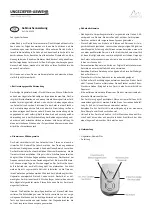
English (GB)
22
7.4 Servomotor
7.4.1 Connecting the servomotor to the rate valve
1. Move back the retention pin (2).
2. The coupling (1) slides down.
3. Turn the adjustment knob (3), until the coupling snaps in.
The servomotor is connected.
Fig. 26
Connecting the servomotor
7.4.2 Disconnecting the servomotor from the rate valve
1. Push the coupling (1) upwards.
2. Move the retention pin (2) through the coupling, until it cannot
move down any longer.
3. The servomotor is disconnected from the rate valve.
4. Now the dosing flow can be adjusted manually.
Fig. 27
Disconnecting the servomotor
7.5 Switching off the chlorine gas dosing system
7.5.1 Emergency stop in case of gas escape
7.5.2 Emergency stop in case of small leakages
1. Put on protective equipment.
2. Immediately close the chlorine container valve.
3. Let the system run until all parts are evacuated.
4. Switch off the system as described in the following.
7.5.3 Switching off while the system is running
1. Close the chlorine container valve.
2. Let the system run, until the measuring glass of the dosing
regulator shows no more gas flow.
3. Close the rate valve at the dosing regulator.
4. Turn off the motive water supply.
5. Close the motive water valves.
6. Close the shut-off valves before and after the injector.
7.6 Changing the chlorine container while the system
is running
The red mark (empty indication) at the vacuum regulator shows
that the minimum pressure of the chlorine container is reached.
The container must be replaced.
1. Close the chlorine container valve.
2. Let the system run, until the measuring glass of the dosing
regulator shows no more gas flow.
3. Close the rate valve at the dosing regulator.
4. Turn off the motive water supply.
5. Close the motive water valves.
6. Close the shut-off valves before and after the injector.
7. Unscrew the vacuum regulator from the connection of the
container.
– Place the regulator into the wall support, if existing.
8. Screw the protective cap onto the empty chlorine container;
put the empty containers away, and protect them from rolling
away or turning over.
9. Position the new chlorine container, and fix it correctly.
10. Remove the protective cap from the new chlorine container.
– All connections must be absolutely clean and dry.
11. Insert the gasket at the pressure connection of the vacuum
regulator.
– Replace the filter, if necessary.
12. Screw the vacuum regulator onto the chlorine container.
13. Check the tightness as described in section
14. Re-start the system.
8. Maintenance
Intervals for cleaning and maintenance
• At least every 12 months.
• Before every start-up.
• In case of malfunction.
TM0
4
075
3 090
8
TM
04
0
752
0
908
Warning
If gas escapes, immediately leave the room and put
on protective equipment.
Start counter measures according to local safety
regulations.
Warning
Repairs of components of the system are to be
carried out only by authorised persons.
3
2
1
2
Warning
Put on the required protective equipment.
Warning
Replace the gaskets at any change of chlorine
container.
Never use the vacuum regulator without filter!
Caution
Do not align the regulator by turning the housing!
If necessary, hold up with a 13-mm fork wrench.
Warning
Check the tightness before re-starting the system.
Warning
Maintenance has to be carried out only by authorised
and qualified personnel.
Before starting cleaning and maintenance work,
switch off the entire system.
Danger of chlorine gas escape!
Warning
Make sure that the system cannot be started
accidentally while working at it.
Warning
Before re-starting, check the tightness.
Danger of chlorine gas escape!
Содержание VGA-113
Страница 2: ...2 ...
Страница 294: ...294 ...
















































